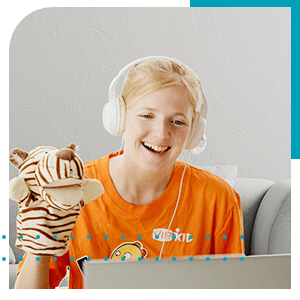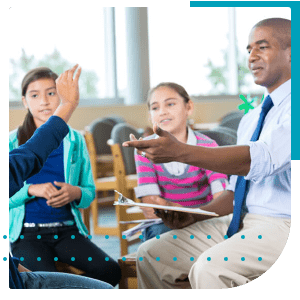Have you ever wondered how English teachers create tailored ESL lessons or courses? Seasoned English teacher and teacher trainer Eddy Salgado, from Nicaragua, walks us through his steps for designing a customized English course for high school students. He also shares what he learned in Bridge’s TEFL course, Specialized Certification in Designing Custom Courses, about identifying his students’ learning goals and implementing interactive activities through digital tools in his online lessons.
Hi, Eddy! Tell us a bit about your background and how you became interested in designing custom courses.
I’ve been teaching general English at a university for nine years and I’ve also tutored high school students online. I have a Master’s degree in Teaching, and I completed several Bridge TEFL/TESOL certifications.
At first, I taught general English to university students who were studying business administration, accounting, social science, and nursing. I began to realize they needed more personalized lessons and my teaching approach was not as effective as I wanted it to be. I was also creating courses for high school students preparing for university studies at the time and decided to look into more training in course design.
I completed some Bridge Micro-credentials and implemented the resources, techniques, and strategies I learned. Then, I decided to take the Designing Custom Courses Specialized Certification course. I wanted to learn strategies to tailor my lessons to my students’ needs and goals since my general English students needed English for particular contexts.

What were your takeaways from the Specialized Certification in Designing Custom Courses?
In general, the certification taught me a lot about the process of teaching, creating a course, and teaching individuals and groups. The course helped me identify teaching methodologies and strategies I wanted to implement in my classes.
What I love the most from the course is that I learned to identify students’ lexical, functional, and structural needs and what I could do for them to meet those needs. That was a game-changer for me. I also learned to analyze and organize those needs, create student-centered course objectives, and then find specific activities for my students. Based on those activities, I also learned to use the functional approach, which is teaching English as it will be used in a specific context.
For example, if I’m going to teach the future tense to high school students, instead of diving into explaining the grammar structure right away, I start with a question like, “What do you think you will do after high school?” Then, I have students make predictions about their futures after high school, which requires future tense verbs. Identifying that functional need gave me insights into teaching strategies that would help students use the future tense in a known context.
Using a functional approach also allowed me to enrich the lexical needs of students based on real scenarios. For example, if a student is planning to attend university or become a doctor, I can teach vocabulary they will use in real situations and combine that with the target grammar structure.
Read about the top strategies for teaching grammar to English language learners.
Ready to master the terms, technology, and teaching tools used in the virtual EFL classroom?
Specialized Certification in Teaching English Online
Get CertifiedGive us an example of how you designed a customized English course for high school learners.
The most important things I considered when creating the English course for my high school learners were the students’ goals, language gaps, and interests. Before creating the course, I conducted a survey using an app called SurveyHeart to learn specific topics students were interested in discussing. Some popular topics students like to discuss and I have included in lessons are music, their favorite athletes, and their favorite sports.
After gathering their answers from the survey, I created the syllabus, selected the materials, and adapted the lessons as I built them.
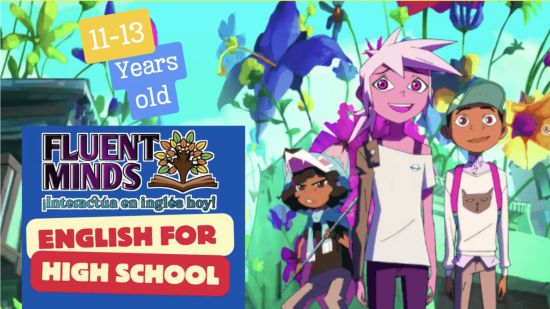
I always start my lessons with an interactive task using digital tools. For this example lesson, I started with a warm-up, asking what students think they will do after high school.
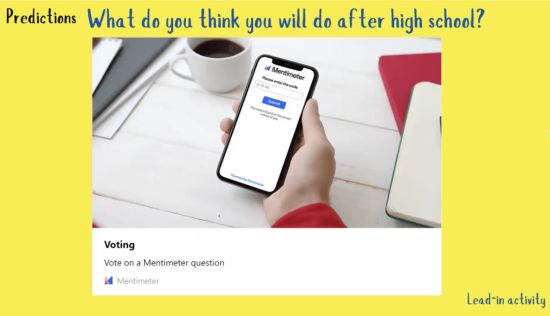
Next, students selected four predictions. This activity provided the opportunity for a functional approach to teaching the future tense as students engaged in context-based language exploration.
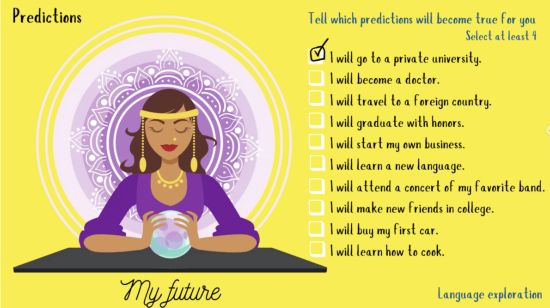
After being exposed to the future tense language examples, students completed an activity on Padlet wherein they had to answer the question, “What do you think you will do in the future?” This provided an opportunity for students to practice writing using the sentences I shared with them or their own phrases.
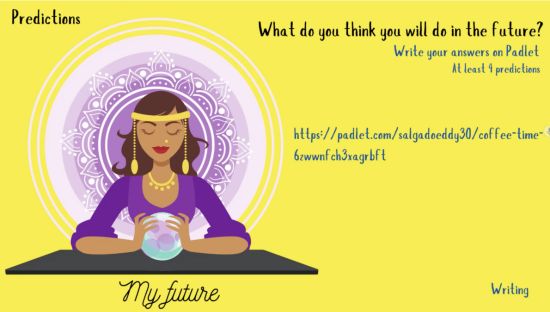
The next part of the lesson was a conversational activity, which followed the same pattern of contextual language exposure, discussion, and then student practice of the concept.
What are some of your favorite digital tools for lessons?
Here are some of the digital tools my students and I love most:
-
Wordwall allows you to introduce language topics in a variety of ways and create games.
-
Genially can be used to create animated content.
-
Interacty can be used for gamifying instruction and creating interactive online activities.
-
Apps like Blooket and Kahoot! are tools for formative assessments.
When selecting the best resources for students, my main criteria are intended age, background, and purpose. For my high school students, their priority was to have fun in the lesson. Their parents also wanted to see results. The digital tools I used needed to meet both of these objectives.
Learn about 26 of the best digital tools for teaching online.
What kind of student feedback did you get on your first customized lesson?
The lesson went great and my students gave positive feedback! I now have a different mindset for teaching and see the value in designing custom courses. My students love my activities and the lessons. At the end of every class, they were excited and satisfied with what they learned.
Most of them also shared they didn’t know they loved English but that now they do because they have fun in the classes and they’ve become more mindful of what they’ve learned. After the class about future tenses, the students also said they liked to talk about their future and the content related to their goals.
Qualify for more jobs and advance your skills with
Specialized Certification in Teaching Young Learners & Teens
Get CertifiedWhat are some tips for personalizing ESL lessons?
After my success, my first tip is to take the Specialized Certification in Designing Custom Courses to learn about methodologies and strategies and apply the appropriate approaches as you design your own custom course while learning. The course has a lot of resources and materials, and you’ll receive feedback on your work from the course tutor.
Another tip is to listen to your students. If your students tell you they want to learn English for buying products, research those scenarios in which the students are going to be using English, and get familiar with the vocabulary the students need.
A final tip is to focus on your students’ learning styles and tailor the activities to them so the activities become meaningful for them. If the activities are meaningful, students will feel motivated and see the results they’re looking for.






